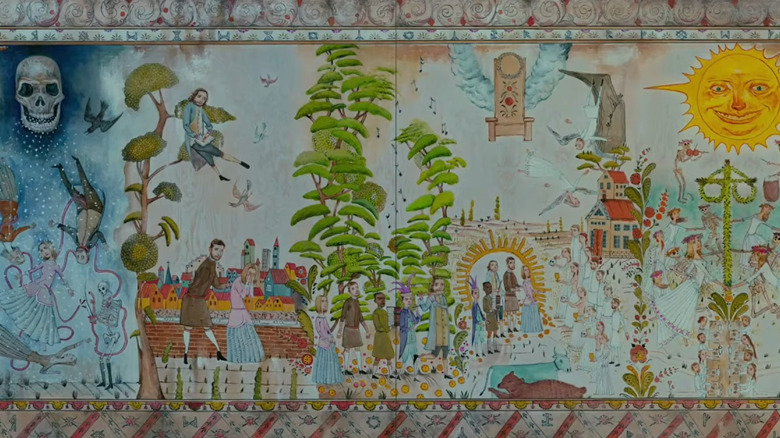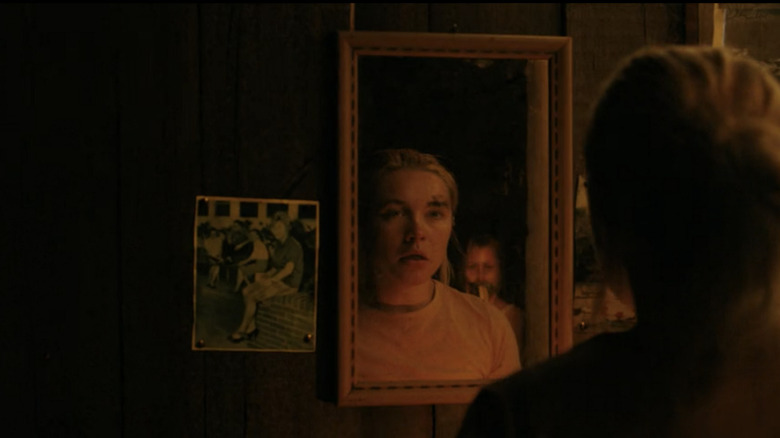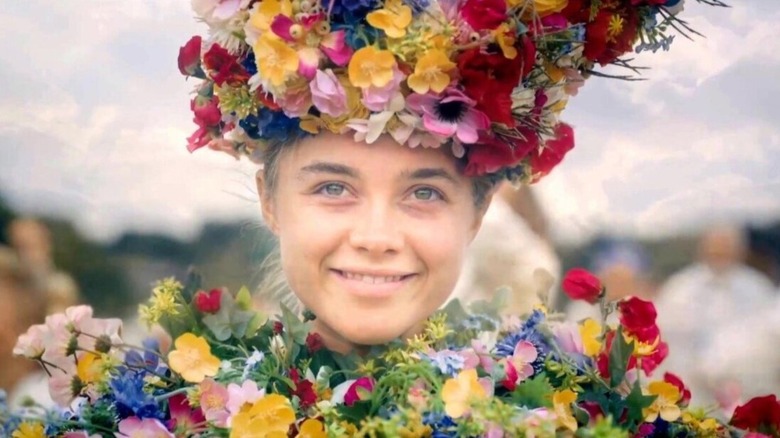Ari Aster Wanted Midsommar's Opening Scene To Feel Like A 'Disney Flourish'
The thing that makes "Midsommar" so compelling is that it's two very, very different stories mixed together. On one hand, it's the heartwarming tale of a young woman who finds her sense of self within a community that embraces her for who she is. After losing her family in the beginning, she finally finds a new one by the end. On the other hand, it's a folk horror story about a group of friends who get murdered and/or brainwashed by an evil cult. A lot of the movie's creepiness comes down to how the story is almost sort of wholesome, if you look at it through a very specific lens.
That's part of why writer and director Ari Aster chose to open the movie with a sunny, innocent-looking mural. The artwork doesn't seem so happy when you look at it for more than a few seconds (just look at that sun's face), but at first glance, there is a sort of childlike, wholesome quality to it. "Disney was a reference," Ari Aster explained to Vox in a 2019 interview, "especially for the very opening moment with the mural that opens the film. I definitely wanted that to feel like a Disney flourish."
The idea of wanting to invoke the feeling of a Disney film at the beginning of your horror movie might seem strange, but it fits with what "Midsommar" is going for. Aster himself explained, "I've always seen 'Midsommar' as a fairy tale."
Orphaning your main character
"Orphaning your main character is the oldest fairy tale move in the book," Ari Aster explained, "and that was important for where the film goes." Even when fairy tales don't kill off the protagonists' parents, the main character is still typically separated from them before the main story begins. The lack of parental figures in these types of stories is often both terrifying and freeing; the character may feel lost and scared without parental figures to keep them safe, but now they have their own agency. They have to make their own choices in life whether they want to or not.
And of course, despite what so many of those Disney happy endings would have you believe, most fairytales go in some fairly dark directions. There are plenty of versions of "The Little Red Riding Hood" where the girl gets eaten by the wolf, just as there are versions of "Cinderella" where the stepsisters mutilate their feet in their vain attempts to woo the prince. Cinderella still gets a happy ending in most versions of her story, but plenty of them take place in a world where horrible acts of violence are casually doled out to the characters around her.
In many of these, it almost feels like the suffering of others is a requirement for the main character's happy ending. It's not enough for Cinderella to leave her evil stepmother and sisters; we also need to hear about how the step-sisters got their eyes pecked out by birds or how they ended up boiled alive. Some versions of the tale end with the sisters being forgiven, but we know those aren't the ones "Midsommar" takes inspiration from.
Two very different movies in one
"I think the fun of the film is that it is a contribution to the 'folk horror' subgenre," Aster explained. "So it goes exactly where you're expecting, but the surprise is in how it feels to get there." For fans of the 1973 film "The Wicker Man," which Aster clearly took as inspiration, it was clear where "Midsommar" was going the moment we saw the trailer; this seemingly friendly community would undoubtedly get up to some evil hijinks, and someone would inevitably be burned alive. But where the rest of Dani's group goes through the same horrific experience of "The Wicker Man's" main character, Dani's arc takes a more positive turn.
"It's like the guys in the movie are in a folk horror movie, but Dani, it turns out, is not," said Aster. "She's in something else, and she's our conduit. She's the person that we're attached to, so it's her movie, not theirs." This is why it's so easy to see the movie as a sort of Disney-esque, Cinderella-type story. Dani's someone who's lost her original family and now feels trapped in an unhealthy relationship with the closest thing to a family she has left. Her boyfriend and his friend group are Dani's stepmother and sisters, and the Hårga is, in its own twisted way, Dani's own Prince Charming.
As the final lines of the film's script put it: "A smile finally breaks onto Dani's face. She has surrendered to a joy known only by the insane. She has lost herself completely, and she is finally free. It is horrible and it is beautiful." At the expense of her sanity and of those who've mistreated her, Dani's finally gotten the Disney happy ending she's always wanted. Doesn't that just warm your heart?


